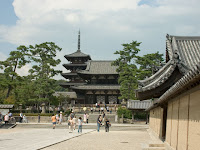For this test, you need to study with the following two things:
1. Calligraphy video transcript
2. My post on the blog about the early history of Japan.
Also, this day is due of the first comparison paper (*see syllabus).
Here are the notes from today's class. Sorry if it looks messy.
===============================================================
縄文時代1,000BC-300BC Jomon Period
The Oldest Period
-縄文土器Cord-marked (=”Jomon”) pottery vessels
-竪穴式住居Pit houses
-狩猟採集生活Hunting and gathering → 稲作の始まりWet-rice cultivation begins
-土偶”Dogu” Clay Jomon figurines (only female figures)
Cord-marked (=”Jomon”) pottery vessels



Pit houses

Clay Jomon figurines (Dogu)

======================
弥生時代300BC-AD300 Yayoi Period
The Beginning of Rice Cultivation
-弥生土器 Yayoi pottery (* “Yayoi” is name of the place where the pottery was discovered.)
-竪穴式住居Pit houses
-稲作の広がりWet-rice cultivation spread all over Japan (except Hokkaido and Okinawa)
→ wealth and poverty, formation of clans, fight against each other
-Yamatai koku: Queen Himiko (in Kyushu region or Kinki region):中国との交流開始 International relations/trade with China starts
-銅器、鉄器の始まりfirst use of bronze and iron-edged tools (for agriculture and battle)
-「倭国」country name:“Wa”
Yayoi Pottery

====================
古墳時代300-710 Kofun Period
The Period of Tumulus, The Beginning of State
-大規模な古墳 Kofun (=ancient tomb)
*墳丘墓Mounded Tombs
*前方後円墳Front-squared and rear round tomb mound
*埴輪haniwa (sculptures to protect and/or house the spirit of the deceased)
-ヤマト王権Formation of the State: the first state in Japan, “Yamato” emerged.
Front-squared and rear round tomb mound

Haniwa


====================
飛鳥時代593-710 Asuka Period
The Period of Prince Shotoku, The Beginning of “Nihon”
-“Asuka” is the name of the capital city (Today’s Nara)
-推古天皇Empress Suiko
-聖徳太子Prince Shotoku 摂政regent to Suiko
← *Christ-like legendary figure
*十七条憲法seventeen-article constitution
*冠位十二階twelve court ranks
http://ha7.seikyou.ne.jp/home/wa-mi/naizou/icon/okanmuri.htm
*Prince Shotoku constructed Horyu-ji temple: the oldest wooden building in the world
*Interaction with China: Kenzuishi (Embassies to China)
仏教伝来introducing Buddhism to Japan from China
漢字伝来introducing Chinese characters kanji
------------------------------------------------------
After Empress Suiko and Prince Shotoku died, Soga Clan got control of politics.
→大化の改新604 Taika Reform (or Great Reform): the oldest coup
Prince Nakano Oe (later Emperor Tenji) killed Soga leader:
centralization of power to the emperor
-Name of the country: 倭Wa →日本 Nihon “Origin of Sun”
Prince Shotoku (on 1000 yen bill)

Horyuji temple

======
奈良時代710-794 Nara Period
The Period of Buddhism
-平城京Heijokyo capital at today’s Nara
-仏教の隆盛flourishing of Buddhism: the establishment of Buddhism as the state religion
*東大寺大仏 Daibutsu (Great Buddha statue at Todaiji temple) established by Emperor Shomu and a monk Gyoki
-文学Japan’s 3 oldest literatures
*日本書紀Nihon Shoki (“Chronicles of Japan”)
*古事記Kojiki (“Record of Ancient Matters”)
*万葉集Manyo Shu (“Anthology of 1,000 leafs” *poetic anthology)
<--use of 漢字kanji and 万葉仮名manyo gana:
Development of Japan’s native writing system
Daibutsu (big Buddha statue) in Todaiji temple

=====
平安時代794-1185 Heian Period
The Beginning of Kyoto as Capital City
-平安京Heiankyo in today’s Kyoto
-武家政治 (Samurai emerged as the guard against bandits →) first Samurai domination of Japan by 平家Heike Clan・平清盛Taira no Kiyomori
-ひらがな、カタカナdevelopment of hiragana, katakana
-女流作家flourishing female writers
*紫式部Murasaki Shikibu「源氏物語」 “Tales of Genji” (*Story)
*清少納言Seisho Nagon「枕草子」 “Pillow Book” (*essay)
-菅原道真Sugawara no Mitizane: Scholar: God of studying and school entrance exam
-空海(弘法大師)Kukai (Kobo Daishi): Monk: The most famous Calligrapher (one of the “Three Brushes”)
<calligraphy: “Shodo (way of writing)” or “Shuji (learning characters)”>
*Three Brushes: Kukai (Kobo Daishi), Emperor Saga, Tachibana no Hayanari
*Three major writing styles: Kaisho (Block style, standard script), Gyosho (semi-cursive style, running script), Sosho (cursive style, grass sccript)
Taira no Kiyomori

Murasaki Shikibu

Seisho Nagon

Kukai (Kobo Daishi)

=====
鎌倉時代1185-1333 Kamakura Period
The Period of the Rise of Samurai’s Power
-“Kamakura” is name of capital city (Kanto region)
-鎌倉幕府Kamakura Shogunate: Samurai government
*“Shogunate” means the government by Shogun (=military general)
*源氏Genji Clan: defeat Heike Clan
*源頼朝Minamoto no Yoritomo: Shogun, leader of Genji clan
*源義経 Minamoto no Yoshitsune:
Yoritomo’s brother in law, played a big role in the battles against
Heike Clan
→Genghis Khan?
*武蔵坊弁慶Musashibo Benkei: monk, Yoshitsune’s follower
----------------------------------------------------------------
-北条家 Hojo family succeeded the power after Yoritomo’s death.
*北条政子Hojo Masako (Minamoto no Yoritomo’s wife)
-元寇Mongolian Invasions on Kyushu by Khubilai Khan * “kamikaze”
Minamoto no Yoritomo

Minamoto no Yoshitsune

Musashibo benkei

Yoshitsune and Benkei

Hojo Masako

Genghis Khan and Khubilai Khan


=====
室町時代1333-1568 Muromachi Period
The Period of Disorder
-“Muromachi” is name of capital city (Kyoto in Kinki region)
-南北朝時代Northern and Southern Courts period 1336-1392
*南朝 South Imperial Court in Nara:後醍醐天皇Emperor Godaigo
*北朝 North Imperial Court in Kyoto:Ashikaga Takauji<--
Samurai(室町幕府Muromachi Shogunate)
→ 北朝Samurai = Muromachi Shogunate win
----------------------------------------------------------------
-応仁の乱 Onin War: over the successor of Shogun (son vs brother) 11 years
→ son won: the son is physically weak → Shogun’s power declined → 戦国時代warring states period
-禅宗の隆盛Zen Buddhism prospers.
-キリスト教伝来1549 Francisco de Xavier, from Spain, arrived at Kyushu region to preach Christianity.
Emperor Godaigo

Ashikaga Takauji

Francisco de Xavier



